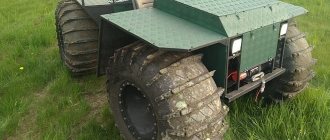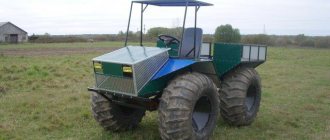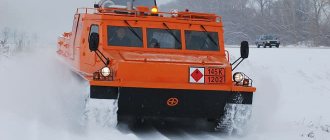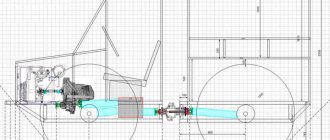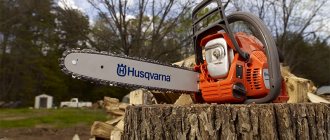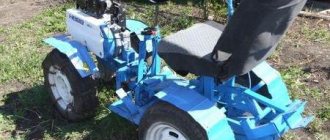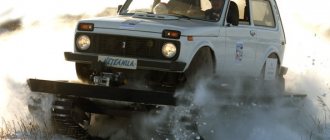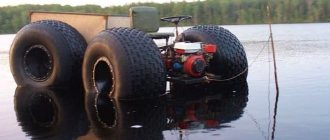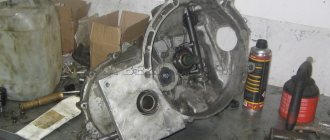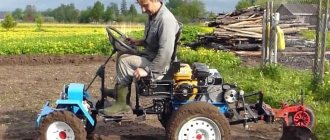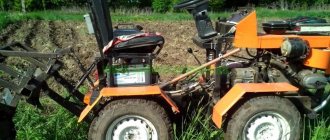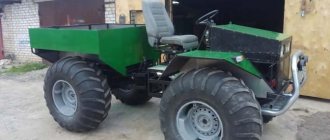Homemade transport is common in Russia. Thanks to the imagination and skill of engineers and simple talented home-made workers, models appear that are not produced at large enterprises. The need for such machines arises in hard-to-reach areas; They are loved by hunters, fishermen and travelers. Particularly popular among them are homemade pneumatic all-terrain vehicles.
Improvements
The simplicity of the all-terrain vehicle forces its owners to make some adjustments to the existing design of the equipment.
In addition, installing a steering damper will make the process of driving a vehicle easier (the steering wheel will stop hitting the driver’s hands). To ensure that the chain does not need to be constantly tightened, some car owners equip it with a simple damper.
In winter cold, the installed windshield and awning covering the cargo-passenger part of the all-terrain vehicle will help protect the driver and passengers from the cold. All modifications to the swamp vehicle can be made independently by purchasing the appropriate parts and necessary materials.
At the request of the customer, additional equipment can be installed at the manufacturing plant that will improve the technical performance of the machine:
- Equip it with a trailer hitch and a towing eye.
- Remove breathers from axles and gearboxes.
- Equip a platform for installing the battery.
- Introduce a cigarette lighter.
- Install halogen or LED headlights, incl. and a spotlight.
- Equip the all-terrain vehicle with soft seats with shock absorbers, incl. and lateral.
- Install the suspension on springs.
In addition, some craftsmen independently make special mounts for the canister, thicken the steering wheel for a more comfortable driving process, and modify the all-terrain vehicle in other ways, making it more convenient and reliable for off-road driving.
Ripsaw EV2
The abbreviation EV is a letter abbreviation for extreme vehicle. Translated from English, this phrase means: “extreme vehicle.” The first all-terrain vehicle of this family was developed in 2001. Today, their distinctive features are fast travel, maneuverability and cross-country ability in any terrain.
The Ripsaw EV2 is an all-terrain vehicle designed for civilian use. Unlike military versions, it has a single, comfortable closed cabin. The main purpose of the vehicle is tourist and recreational travel.
EV2 all-terrain vehicles are constructed from high-strength composite materials.
Its weight is about 4.5 tons. This is also facilitated by the lack of reservations. The design of the Ripsav EV2 all-terrain vehicle includes modern-type tracks, seagull doors, and a diesel engine of more than 700 hp. pp., hydrostatic transmission. The car accelerates to 80 km/h in 5.5 seconds. On rough terrain, the speed can reach 100 km/h.
General design features
Lesnik-M, unlike Lesnik, has a glass half-cabin, a protective compartment for the engine and a stove. The details of the body configuration differ slightly.
Lesnik M-Server differs from Lesnik-M by a body made of duralumin metal, with interior ventilation and a completely insulated engine compartment. The design of the transmission, as well as the material for the production of body parts, are the same in all trim levels.
The most expensive and important part of an all-terrain vehicle is the special ultra-low pressure wheels.
The tires on them come in different types; they are selected individually depending on where the equipment will be used.
The snowmobile body is made of a profile pipe, covered with aluminum sheets, painted with special anti-corrosion paints. The engine and gearbox are installed in the middle of the frame, which allows the swamp vehicle to maintain its center of gravity when overcoming water obstacles.
The carburetor power unit is installed from a VAZ-21083 passenger car, and the injection unit is installed from a VAZ-2111. The cooling system has 2 modes, allowing you to cool the engine in any operating conditions. It is possible to install a 3-cylinder Japanese KUBOTA engine running on diesel fuel.
The drive axles and cardans are installed from the UAZ-469, the suspension is spring type.
There are 3 pedals: gas, brake, clutch. On the right side is the gear shift lever. Snowmobiles are equipped with lights, stops, and turns.
Low pressure wheel manufacturing technology
First of all, you need to get rid of the wire cord. To do this, an incision is made on the sidewall of the tire, the cord is cut with cutters and stretched along the entire perimeter of the wheel. After removing the first layer of cord, the standard tread is pulled off using a winch. To do this, fix the tongs on the incised area, load them with a winch and trim them with a sharp knife so as not to remove the excess layer of rubber.
When the tire is processed, a new tread pattern is applied, depending on the operating conditions of the future wheel. The protector is cut with a sharp knife. When the tire is ready, the disk is assembled.
At the same time, they try to make the design as light as possible. Examples of such homemade disks are shown in the photo.
After this, the wheel is assembled, the chamber is inflated to the required nominal pressure, and rubber bands made of reinforced conveyor belt are used to securely fix the tire to the disk. Here is an excellent example of exemplary homemade tires installed on welded wheels on a UAZ 469.
Ready-made wheels can be used on swamp vehicles, ATVs, snowmobiles, and regular off-road vehicles. Happy experiments everyone!
Car enthusiasts have probably come across serial or home-made vehicles with huge wheels installed. Such wheels are produced mainly on special orders. Such designs are called low-pressure tires, or LHP for short. Such tires are quite widely used on military vehicles, fishermen, travelers, hunters, agricultural and geological exploration equipment.
The name itself immediately defines the main distinguishing feature of these tires - wheels of this type have low pressure, so in appearance they resemble the cushions on which the car moves. SNDs exert little pressure on the coating, resulting in an optimal effect for off-road driving. Despite the reduced pressure on the ground surface, the degree of traction still remains high, which allows you to confidently move through rough terrain, swamps and mud.
Numerous studies have shown that low-pressure tires are 20% more efficient than standard tires.
SND have several distinctive features:
- Due to their special design, these tires have an increased area of contact with the surface, thanks to which cars on such tires can overcome almost any obstacle.
- Driving a car equipped with such wheels requires special skills. It is recommended to drive on hard surfaces as little as possible and to take turns smoothly, since the side surfaces of the SND are their weakest point and are very unstable to wear.
The low specific pressure makes it possible to use such tires on agricultural machinery, since when cultivating the soil it is necessary to ensure minimal loads on the ground. For the same reason, SNDs are used on a variety of all-terrain vehicles.
Depending on the design architecture and functional characteristics, several types are distinguished:
Line of models with descriptions
The snow and swamp-going vehicle has several modifications.
All-terrain vehicle Extreme
The equipment was intended for transporting goods and passengers along roads with soft soil, through swampy areas, and for passing water obstacles. The new Lesnik Extreme 2022 has good driving characteristics. He is able to independently move out of the river onto the ice without a winch. The tent top and comfortable interior allow you to organize an overnight stay, and a good stove will keep you warm in cold weather.
The all-terrain vehicle has the following characteristics:
- length - 435 cm;
- width - 254 cm;
- height - 270 cm;
- curb weight - 1750 kg;
- ground clearance - 65 cm;
- number of places - 7;
- fuel consumption - 15-30 l/100 km depending on operating conditions;
- load capacity on hard soils - 500 kg;
- load capacity on water and weak soil - 300 kg.
The equipment is equipped with ultra-low pressure tubeless wheels, sizes 1600/700/635. The Extreme all-terrain vehicle has a Japanese-made KUBOTA diesel engine with a volume of 1.5 liters, a power of 44 hp, and a torque of 120 N*m.
It has a rear leaf spring suspension and a disc transmission brake system. The bridge is equipped with a forced lock. The vehicle is equipped with centralized tire inflation and a 60/80 cm hatch.
Profi and Profi Tent
The snow and swamp-going vehicle Lesnik Profi has high cross-country ability in bogs and is equipped with an all-metal duralumin body. The cabin of the car is well insulated, with interior decoration.
All-terrain vehicle performance characteristics:
- length - 470 cm;
- width - 254 cm;
- height - 280 cm;
- curb weight - 1950-2150 kg;
- ground clearance - 72 cm;
- number of places - 8;
- fuel consumption - from 15 to 30 l/100 km;
- load capacity on hard soils - 700 kg;
- load capacity on soft soil - 500 kg.
The snow and swamp-going vehicle has ultra-low pressure tubeless wheels TREKOL size 1600/700/635. The model is equipped with 2 types of power units:
- gasoline engine from VAZ-2123 with a volume of 1.7 liters, a power of 81 hp, and a torque of 128 N*m.
- Japanese diesel power unit KUBOTA 1505 T with a volume of 1.5 liters, a power of 44 hp, and a torque of 128 N*m.
Both work with 5-speed manual transmission from the VAZ-2115. The rear and front suspensions are leaf springs, from the UAZ. The brake system is transmission, disc. The bridges are installed from GAZ-66 or Volvo cars.
Forester Tent has the same characteristics as the Pro. The tent cabin retains heat at sub-zero temperatures. The curb weight was reduced due to the awning - 1700-1900 kg. The load capacity has increased: on hard soils 900 kg, on loose soils and water - 600 kg.
M-North
The Lesnik-M Sever all-terrain vehicle has an all-metal duralumin insulated cabin. Doors and windows with high-quality sealing, which allows you to organize an overnight stay in the car at sub-zero temperatures.
This model has the following technical characteristics:
- length - 370 cm;
- width - 228-232 cm;
- height - 260 cm;
- curb weight - 1450 kg;
- ground clearance - 49 cm;
- number of places - 6
- fuel consumption - 15-30 l/100 km;
- load capacity on hard ground - 500 kg;
- load capacity on loose soil and water bodies - 300 kg;
- maximum speed - 40 km/h.
The Vologda swamp vehicle is equipped with tubeless low-pressure tires TREKOL size 1300/600/533 or 1350/700/533. This model is equipped with a gasoline injection engine from the VAZ-21114 - 1.6 liters, 82 hp, with a torque of 125 N*m. The engine is combined with a 5-speed manual transmission from a VAZ 21083. The rear suspension is leaf spring, the front one is missing. Disc brakes, hydraulic, with vacuum booster.
Important Russian military all-terrain vehicles: tracked and wheeled amphibians for small army units
Forester Light
The cabin of the all-terrain vehicle is made of solid material - fiberglass. The cabin is well insulated and suitable for winter overnight stays at sub-zero temperatures.
The snow and swamp-going vehicle has the following technical characteristics:
- length - 370 cm;
- width - 232 cm;
- height - 240 cm;
- curb weight - 850 kg;
- ground clearance - 48 cm;
- load capacity - 500 kg;
- load capacity on loose soil and bogs - 300 kg;
- maximum speed 50 km/h;
- number of places - 7.
The Lesnik Light all-terrain vehicle is equipped with a gasoline, carburetor power unit from the VAZ-2106 - 1.6 liters, 80 hp, with a torque of 125 Nm. Works with a 5-speed manual transmission.
Let's start production
First, we get rid of the outer bundle of wire cord. To do this, we cut a window, cut one of the turns with wire cutters, and wind the wire around the pliers and pull it out along the entire diameter. Then we cut the entire sidewall in the direction from the cord to the tread at a distance of 7-10 cm from each other. The depth should reach the first layers of cord.
Using a piece, the fang is undermined. We use a knife and trim only along the edges of the fang. The fang is undermined strictly clockwise, otherwise the top layer of cord will appear on the right.
The formation of the tread of a future tire should begin with graphic markings. The tread pattern in low-pressure tires with your own hands is determined by functionality, complexity and imagination. The most common and easiest to manufacture is the “herringbone” option with or without a central flange.
For the base it is better to select truck tires
Having drawn the entire drawing, we proceed to cutting the contours. In this case, the knife blade is placed at such an angle to the surface that the cross-section of the tread has the shape of a regular trapezoid. Thus, having cut through all the ends of the outlined pattern, you can begin peeling. Usually the preparatory process takes most of the time and requires perseverance and patience. However, the peeling process itself, its speed and accuracy will depend on the preparation.
How to do it yourself
Homemade versions of an all-terrain vehicle are easy to make if you have an equipped workshop. The drawings are freely available on the Internet. The base for the car is the same GAZ-66.
There are options for modifications of the GAZ-66, mounted on tracks. In this version, the car reaches speeds of up to 50 km/h. Moves through swamps and deep snow with ease. The ground pressure on the tracks is only 0.14 kgf/cm².
The width of the caterpillar is 600 mm. The car has a cabin and a thermal booth. The all-terrain vehicle is equipped with a 90 hp diesel engine. In this version, the transfer case from the base model is retained. The weight of the all-terrain vehicle after all modifications is about 3 tons. The design of the vehicle allows it to transport both passengers and cargo off-road.
Required spare parts
To build a homemade all-terrain vehicle based on the GAZ-66, you need:
- frame;
- bridges;
- Nissan gearbox;
- steering column from the base model;
- T-150 wheels;
- four-cylinder diesel engine;
- cabin from Niva.
You will need:
- welding inverter;
- Bulgarian;
- drill;
- set of wrenches;
- plumbing and measuring tools.
Step-by-step assembly process
During the work:
- The springs are lighter. To do this, the sheets are removed from the front and back.
- Brakes are being replaced.
- The housing from Niva is being installed.
- The transfer case is installed. The original model is not more reliable than the base model, so a different layout option is selected. This unit, removed from the ZIL 157, is excellent. But now it is quite difficult to get one that is working and in good condition.
- The cardan shaft is shortened, the RK66 traverse is shifted by 20 cm. This is necessary because The spare part taken from Nissan does not fit in length.
- The engine is installed on special brackets.
- It is best to take the steering from the ZIL, but in this case you will have to shorten the bipod.
When creating the car, the original thrust from the GAZ-66 is also shortened.
Mounting the cab from the Niva does not create any problems. It is carried out at three points using M12 bolts.
All all-terrain vehicles created on the basis of the GAZ-66 cope with the functions assigned to them and can be used in many areas of the national economy.
Design of a lightweight karakat all-terrain vehicle wheel on tubes
On the rim, the role of a tire is performed by simple two tubes from a car measuring 1200 by 20. The first one, put on the wheel rim, performs the work of the tube, is intact and inflated. The second one is cut along the inner diameter and put on the first one, fulfilling the task of the tire and protecting against punctures.
A cover is placed on top of the tire to increase the controllability of the all-terrain vehicle. It is made from a conveyor belt. The tape is first marked on belts with a width of 50 mm, number 1, and 30 mm, number 2. It is more convenient to mark with a meter ruler and a ballpoint pen.
Then, with the help of a sharpened ax and a massive hammer, it is cut down. The ax is placed on the marking line, and blows of the hammer on the butt of the ax easily cut through the tape. The resulting belts are again marked at connection points. At the joints in the belts, 4 holes for the bolts are punched with a special punch.
If you don't have a punch, you can quickly make one. A tube with the required internal diameter is selected. An arbitrary segment is cut off. On one side it is sharpened sharply. The punch is ready. You need to place a wooden surface (chock) under the belt to be punched.
The cover is assembled and firmly fixed using 3 bolts welded to the rim.
Design and operating principle
Amplifiers are installed inside the steel case, on which the transmission units and engine are mounted. Torque is transmitted using a belt clutch to a driven sprocket, connected by a roller chain to a manual transmission from VAZ cars. The transmission is connected to the drive axle by a cardan transmission; the drive wheels have protrusions that engage with corresponding recesses in the track. The rubber band has metal reinforcements that extend the life of the unit.
The transmission ratios allow you to start moving at 4th speed without the risk of stopping the engine. The track tension is regulated by the pressure in the pneumatic tires of the road wheels; the tires simultaneously reduce the level of vibration when driving over rough terrain. The all-terrain vehicle is floating (subject to hermetically sealed welding); movement on water is ensured by the rotation of the caterpillar tracks.
The machine is equipped with hydraulic disc-type brake mechanisms, borrowed from the VAZ-2108 car. Stopping is accomplished by pressing the pedal; fluid is supplied to the calipers through flexible lines. The design of the rear axle uses a standard differential; an optional forced locking mechanism is installed, which improves maneuverability on soft ground.
Separately about the rotary mechanism
The Okhotets all-terrain vehicle turns due to the use of a differential in the transmission design, which is braked by 2 levers installed near the driver’s seat.
When the track is fully braked on one side, the all-terrain vehicle turns on the spot.
Pros of the Lifan engine
Main advantages of the power unit:
- The 4-stroke gas distribution system provides for filling the tank with clean gasoline;
- To cool the cylinder, a fan is used to direct the air flow to the fins;
- electronic ignition unit simplifies the starting procedure;
- the electric starter is duplicated by a manual drive;
- to reduce the effort when cranking the crankshaft, a decompressor valve is installed;
- reduced weight and dimensions;
- high power and the ability to run on gasoline with an octane rating of 92 units or more.
MY MOTORCYCLE
Of course, motorcycles can be divided according to cross-country ability, but who can be called a champion....... and the winner in terms of cross-country ability can be called a little-known type of motor vehicle - pneumatic: a type of motorcycle with huge tires. Such motorcycles (and they are made of nickel) are quite popular in difficult areas of our planet: the tundra, the far north, etc.
Due to their huge size and ultra-low pressure inside (about 0.2-0.3 atmospheres), they provide a wide contact patch and, as a result, low pressure on the ground. That is why a pneumatic vehicle is capable of driving not only through any mud, swamp and snow, where there is nothing for other vehicles to “catch”, but even to swim.
Pneumatics are the most environmentally friendly type of ground wheeled transport - they do not destroy grass cover. Nature will especially highly appreciate this quality when used in the North, in the tundra, where the “scars” from any tracked or wheeled vehicles do not heal for years.
For those who are tight on money for a new snowmobile, but have their hands in the place, a motorcycle turned into a wheeled snowmobile is a panacea for all transport ills. In addition, pneumatics, in comparison with the most common snowmobiles on tracks in hard-to-reach regions, have a lot of undoubted operational advantages. The most significant thing is low fuel consumption and all-season use. Another important “plus” is a guarantee of safety during winter driving on ice in water bodies: if you get into an ice hole, you won’t drown.
A little about the variety and design
There are two- and three-track pneumatics. Three-track ones are the simplest - in their design, more than half of the “stuffing” of the motorcycle is preserved. The fact that this is really simple is confirmed by the fact that in the North all existing brands of domestic motorcycles and even mopeds are converted into pneumatics. The front fork stays are replaced by two pipes with strongly spread lower ends so that a large wheel fits between them. On some, they leave the fork with the “native” motorcycle wheel, but attach a ski to it (in this case, the further forward the ski is placed, the better the cross-country ability on soft snow). It's easier. However, in this case, the pneumatic tire loses its buoyancy, as well as the ability to ride in the summer. Instead of a standard pendulum, an axle with two wheels is installed at the rear. Theoretically, it is possible to make a pneumatic with one wheel at the back (like a regular single motorcycle), but only stuntmen could ride such a device.
The cameras are wide, they seem to be under-inflated, because everything that rests on them is constantly “floating” - the design reacts completely inadequately to obstacles. Therefore, maintaining balance on a two-wheeled caracat (from someone’s light hand this ironic nickname was assigned to pneumatics) is very difficult.
Although judging by the photo, “Kulibin” solved the problem - he put skis on the sides! As an option, a pneumatic circuit with a front ski instead of a wheel! So, the two rear wheels are mounted on the same axle.
In the simplest designs they are always rigidly connected to the axis. Due to this, high throughput of the device is achieved. But serious problems arise in corners. More precisely, on slippery soils (snow, mud, swamp) there are no problems, since one wheel slips freely. But on dry surfaces it is difficult to make a turn along a small radius: resisting the maneuver, the rubber is greatly deformed and wears out faster. You will get rid of this if you install a differential, for example, from “Ant”. Unfortunately, its design does not include a locking device, and this is a big disadvantage when driving on “steep” off-road conditions. Many do-it-yourselfers solve the problem simply: they always make only one wheel leading, which is quite enough when driving on hard, dry surfaces. And when the ground grip of the chamber is not enough, the second wheel is also firmly fixed. To do this, a special pin (or bolt) is inserted into the hub and axle. 1. Pneumatic with intermediate gear. 2. All-wheel drive pneumatic with a “breakable” frame. 3. Pneumatic “4x4” with differential from “Ant”. 4. Pneumatic with a differential from “Ant”, turning due to the braking of the wheels. The ideal option is to use a bridge from the Kovrov four-wheeler “ZDK-175 4ShP”. Its design provides reduction gear, reverse gear and differential lock. However, buying such a bridge is quite difficult, and its cost is probably comparable to the price of a new motorcycle. Due to the fact that the wheel diameter is almost twice as large as that of standard motorcycle wheels, the transmission ratio will have to be increased. There are three ways to do this: install the above-mentioned “Zidov” bridge, in which there is a reduction gear; make a driven sprocket of “huge” dimensions (with the number of teeth 70-100). Or introduce an intermediate downshift. It is extremely simple: a shaft on two bearings and a pair of sprockets. Most designers follow this path. All power transmissions in such a transmission are carried out by chains. Often, combine harvester chains with an unusually large pitch for motorcyclists are used for this - 25.4 mm. By summer, the three-track pneumatic is usually converted back into a regular motorcycle.
Double-track pneumatics are made with four, less often six-wheeled ones. Their cross-country ability is significantly higher than three-track ones. This is understandable: the more wheels (in some models they are all driven), the easier it is to overcome the resistance to movement. But you have to pay for higher cross-country ability - such a device has little in common with a road motorcycle, it cannot be a transformer - you cannot turn it into a two-wheeled motorcycle by summer. This is a serious car: with a completely homemade frame, most of its components are homemade. Few four-wheeled pneumatics retain the motorcycle riding position and controls. Most have car comfort: seats with backrests and a heated cabin.
Some designers increase the buoyancy of cars: they make the hull airtight, install a propeller or an additional outboard motor.
Turning of double-track pneumatics is carried out like an automobile (with the front wheels) or by means of a “breaking” frame. Less common are tractor-like turning patterns - with the braking of wheels located on one side of the vehicle. Pneumatic suspensions are most often absent - their role is played by the cameras themselves. The vertical deflection of the chambers can reach up to 150 mm, which is equivalent to the travel of the suspensions. However, for driving at high speed over rough terrain, energy-intensive suspensions are still far from unnecessary. Tubes from all-terrain trucks or agricultural trailers are used as tires on pneumatics (it’s not difficult to understand why not bicycles). The “squarer” the chamber is in cross-section (that is, the closer the ratio of the chamber width to the bore diameter), the better. As practice has shown, the best cameras are from airplanes and helicopters. They are made from rubber of the best composition. The quality of their manufacture is also significantly higher: the thickness of the walls of these chambers is the same at all points. If aircraft cameras cannot be obtained, home-made cameras are content with products from ordinary trucks, and they are paired - attached side by side to each other.
It is not difficult to make disks (framework) for attaching any cameras. They are attached to the disks with belts, usually with a conveyor belt from agricultural machines. There are also specially designed ultra-low pressure wheels. They are a tubeless thin-walled tire with a mechanically fastened sidewall to a special disk. They also use wheels from the Arctictrans association - with light, thin-walled corded tires. The wheels have a small tread and are therefore more durable. One thing is bad: such wheels are rarely found on sale, and their price is high, so they are difficult for DIYers to obtain. No matter how you look at it, there is no such thing as perfect
There is no such thing as perfect in technology. Pneumatics also have disadvantages. The first and most important scourge of “crooks” is the fragility of the cameras. The large dimensions of the wheels and the absence, as a rule, of a differential make these cars clumsy, and the low pressure in the chambers deprives the driver of precise control. When driving at above-zero temperatures, dirt and water flying from the wheels are annoying - it’s not at all easy to cover such large wheels with wings. Therefore, it is better not to drive on public roads with pneumatic tires. The cross-country ability of a pneumatic in deep snow is still worse than that of a tracked snowmobile (at least the Buran). Only all-wheel drive 4- and 6-wheeled designs can compete with Buran in cross-country ability.
A little history
The human desire to increase the cross-country ability of a motorcycle is as old as the motorcycle itself, but the most successful version of its implementation - designs on ultra-low pressure tires - appeared relatively recently. It is difficult to say exactly who and where built the first pneumatic. But as an option, we can consider the apparatus of Tula father and son Vladimir and Vyacheslav Laukhin to be the first to be “lit up” in the press. In the early 80s, living in Tula and not having a scooter was considered bad manners. He was in the Laukhin family. The head of the family attached two cameras from a farm trailer to his semi-homemade “Ant” in place of the rear wheel, and a plywood ski in front. On this all-terrain vehicle, the inventors plowed through suburban swamps, fields, and frozen ponds. There were some incidents: more than once at night, truck drivers, not figuring out where the road was in the dark, drove onto a slightly snow-covered track from an “Ant” all-terrain vehicle and... ended up in arable land. They say they were looking for an inventor to punch them in the face... Like ripples on the water, rumors about a miracle device spread in all directions. The idea of the people's "rogue" was picked up and the magazine "Modelist-Constructor" began to "promote". All-Union Society of Inventors and Innovators, DOSAAF. From 1984 to 1991, all-Union competitions for home-made pneumatic all-terrain vehicles were held. It is curious that at the second such competition, held in Arkhangelsk, many DIYers gathered with their devices made... from plywood. In appearance they looked more like boats than land vehicles. The motorcycle engine drove two pairs of rear balanced chamber wheels from the GAZ-53. The front wheels were suspended on a transverse balancer. These are the six-wheeled caracats that appeared before the eyes of amazed journalists.
Long-distance runs across the North have become widely known. After them, the number of pneumatic ones increased sharply. By the end of the 80s, in the Arkhangelsk region alone there were 11 thousand of them, and in total there were about 100 thousand of them in the North. Naturally, with such a surge of interest in pneumatic all-terrain vehicles, attempts were made to produce them in series. In Neftekamsk, pneumatics were produced for several years, based on Voskhod. About 800 of them were collected. Later, in Zelenodolsk, at the Sergo Plant, several hundred three-wheeled motorcycles were made based on the liquid Izh Jupiter. The general decline in motorcycle production in the late 90s again transferred the production of Russian pneumatics to private garages and sheds. Recent years in the north have been marked by some surge of interest in cars with ultra-low pressure tires. The main reason is that the North needs environmentally friendly transport that does not destroy the tundra. However, a modern pneumatic is no longer the same as it was 30 - 34 years ago.
The driver and passengers are in a comfortable cabin, and high driving performance is achieved by an effective suspension and a large number of wheels (usually six), made using special technology. Yes, this is more like a car. But life was given to him by a motorcycle…….
Maintenance, repairs and modifications
Maintenance of the Karakat Hunter requires minimal effort and time, especially if the “Lite” version is used. This option is cheaper than the basic one, as it is a lightweight package with the same functions as the original. Fracture Hunter Light allows you to go through uneven terrain without losing traction. Maintenance consists of timely lubrication and preparation of removable parts, provision of fuel, and replacement of damaged parts.
Repairing caracats yourself is allowed only if you have skills in this area. For repairs at home, you will need tools, a garage with a lower level, and supplies. Since the breaking system is used when passing through difficult terrain, the rotary assembly that ensures its operation may fail with frequent use. If the adjustment is carried out by specialists or people with extensive experience in the field of mechanical engineering, the result will be positive.
Modifications to the Hunter allow you to fine-tune the vehicle to suit your needs. For example, make a caracat based on the Hunter “Lite” with a gearbox from a VAZ 2108. Modification of the gearbox ensures ease of operation. Craftsmen are refinishing the frame and body - drawings of craftsmen appear on forums to support beginners.
The Hunter all-terrain vehicle will help meet the needs of those who deal with impassable terrain at a low price. The unit is suitable for mechanics with high demands and unpretentious drivers.
Ripsaw EV3
Models F2 and F4 are structurally different in standard sizes and cabin features. The main components and assemblies are identical. When purchasing, you can choose different engine and chassis configurations. Like previous versions of the manufacturer’s all-terrain vehicles, Ripsaw EV3-F1, EV3-F2, EV3-F4 have a modular platform.
If necessary, you can change the power plant to suit customer requirements. And also replace some other systems, components and assemblies of the all-terrain vehicle. They can be of various types and brands, differing in technical and operational characteristics. All-terrain vehicles of the family can be equipped with gasoline (500-1500 hp) or diesel (500-1000 hp) engines. The fuel system can be equipped with one or two fuel tanks. Their total capacity is about 120 liters. Power is transmitted to the stern drive wheels through an automatic transmission.
Important FAW Jiefang Sales Record 2020
All-terrain vehicles Ripsaw EV3, EV2, M5 have different configurations, modifications, and versions. They are intended for civil and military purposes. These are high-power vehicles with excellent maneuverability on any terrain, with many advantages over analogues from competing manufacturers.
What is a low pressure tire
Special-purpose tires are a way out of a situation when you need to quickly convert an SUV into a full-fledged all-terrain vehicle. The easiest way is to make low-pressure wheels with your own hands. There is nothing complicated in their manufacture, and the price of homemade tires is several times cheaper than factory ones. First, it’s worth understanding the features of such tires and seeing in what cases and on what vehicles their use is most rational.
Equipment on low-pressure wheels is not afraid of swampy terrain, sand, or rocky roads. The pressure in such wheels is about 2 kg/cm2, due to which any obstacle in the path of the tire is overcome thanks to the high elasticity of the rubber and the large volume of air. Branded low-pressure wheels can cost no less than half the entire car, which is why many people make them themselves. Such a tire works in the same way as the wheels on an ATV or a wheeled snowmobile - it distributes the load on the soil more evenly, and due to the large contact area of the tire with any surface, the all-terrain vehicle does not fall through and can move even on loose snow.
Modifications
As already described above, the manufacturer provided buyers with the opportunity to equip the purchased unit in accordance with personal preferences. The Vologda swamp vehicle and all-terrain vehicle Okhotnik is equipped with the following additional elements:
- body protection;
- cabin seal and glass windows;
- kung on the swamp vehicle Okhotnik M;
- glass cleaner;
- rear towbar in the form of a ball;
- platforms for winches on both sides;
- cigarette lighter in the cabin;
- awnings for cabins and kungs;
- PVC parking awning;
- generators, new or used;
- set of winch, platform, generator and sockets;
- self-blocks - VAZ, UAZ or Volga bridges;
- power steering;
- steering gear;
- breathers;
- improving the quality of spare parts;
- dampers;
- spare belts;
- windshield with frame;
- beadlock wheels;
- spare wheel and inner tube;
- soft seat with shock absorber, new or used;
- soft backrests in the body;
- box for spare parts;
- seat cover;
- rigid coupling.
Thanks to the listed functions, you can equip your swamp vehicle to the highest standard, or choose a model without improvements.
There are homemade ones with other bridges, increasing the power, which are done by craftsmen with their own hands, but to overcome obstacles, the stock equipment of the transport produced in Vologda is enough.
Typical models of breakaway all-terrain vehicles
We should focus on two typical models that have gained particular popularity. The remaining, less common all-terrain vehicles are designed, by and large, in a similar way.
All-terrain vehicles will be discussed below:
- Bobik;
- Toptyga.
All-terrain vehicle Bobik
This all-terrain vehicle can move at speeds of up to 25 km/h, carrying a load of up to 300 kg if it moves on land, and up to 200 kg if it moves on water. 300 kg of cargo is great for a fisherman, and not bad for a hunter.
The front semi-frame is made of a profile pipe, and the engine is located on it. In general, the front half frame is a control center. In addition to the engine, all the main components and assemblies are installed on it, as well as the driver’s seat. The rear semi-frame is made in the form of a trapezoid and is used for transporting goods. Essentially, she is a trailer.
The frame covering is made of painted sheet metal.
As for the overall dimensions of the all-terrain vehicle, they are minimal. Initially, it was planned to equip the equipment with a small, low-power engine. To increase its usefulness, they tried to reduce the weight of the all-terrain vehicle as much as possible.
One of the main tools in this technique is the turning unit, which was created on the UAZ front axle steering knuckle.
A simple passenger seat from a GAZelle is used as the driver's seat. It is installed quite high from the ground. This is reasonable: the higher the driver sits, the better and farther he can see. And this greatly contributes to the effective overcoming of off-road conditions. A full-fledged car battery is installed under the driver's seat.
The design and operating principle of the transmission should be considered in detail. Here are the following features:
- torque from the engine is transmitted by 4 belts;
- The box pulley is mounted on a support shaft. This way the box shaft is unloaded;
- the pulley on the engine rotates in a bearing from a VAZ-2108;
- the gearbox input shaft is used from a VAZ-2106;
- The design also uses a 5th belt that goes to the generator.
4 belts included in the transmission design are a guarantee of reliability. You can get by with just one belt, but it will wear out very quickly.
The gearbox available in technology is made on the basis of the hub of a VAZ car. The engine of the all-terrain vehicle is carburetor. The steering system is created on the basis of steering elements of VAZ-2106 and M-2141 cars.
Some off-road enthusiasts complain that there is no differential lock. But the development and implementation of this system would significantly complicate the design of the all-terrain vehicle and make it heavier. In general, the equipment is highly capable, can float, and most importantly, is economical.
All-terrain vehicle Toptyga
Toptyga differs from Bobik in appearance, and also, not critically, in structure. If Bobik was created, by and large, on the basis of the VAZ-2106, then Toptyga is the result of combining parts from cars:
- OKA – engine assembly;
- GAZ-2410 – bridges;
- M-2141 – steering;
- UAZ-469 – fuel tank, steering knuckle.
The all-terrain vehicle frame is also made of pipes. All main components are located on the front half-frame. And at the back there is only a fuel tank.
There is also a Toptyga-2 model. Which is slightly larger than its predecessor. On the second Toptyg bridges from the UAZ were installed, but otherwise everything has not changed much.
Advantages and disadvantages
Wheels have many advantages over purchased wheels:
- Price. All-terrain wheels are very expensive, which can’t be said about the wheels.
- Such wheels have excellent adhesion to almost any surface, which significantly reduces the risk of accidents.
- The husks weigh relatively little. An “unpumped” passenger car engine will be quite capable of cranking them.
- Low surface pressure due to the large tire area. With encouragement, muddy terrain, quicksand and deep snow become quite passable obstacles. The tire pressure on the surface can be adjusted. They just need to be pumped up or lowered a little.
- Tires with low pressure do not harm the surface soil layers in any way, so you can safely drive an all-terrain vehicle with tires across plowed fields or use it as a tractor in agriculture.
They are also not without some disadvantages :
- You should try to ride less on hard asphalt and concrete surfaces. Otherwise, they will have to be changed very soon .
- A car on such wheels is not very stable. It’s better not to make sharp turns on it, and you shouldn’t drive it fast at all.
- Wheels wear out much faster than normal ones.
- Encouragement is a considerable burden. Transmission and suspension parts with such wheels will have to be changed and repaired more often.
- Low pressure tires are very flexible. This increases their permeability. But due to their increased stretchability, tires get punctured more often than regular tires.
- The car will have to be re-registered - “upgraded” to the status of an all-terrain vehicle.
Fracture. Where does this name come from?
The breakaway all-terrain vehicle is called that way because of the peculiarities of its design. It consists of two half-frames interlocking with each other
The semi-frames are independent, which is very important. They can move as desired relative to each other horizontally, rise and fall in the vertical plane
Due to this design, the high patency of fractures is ensured, and as a result, their great popularity among the population. Such all-terrain vehicles almost never have wheels hanging out, which guarantees excellent traction.
If we continue the conversation about the design of all-terrain vehicles, we can note that, for the most part, such equipment is a piece product, therefore, each vehicle has its own equipment. Of course, the general principle of the device is the same: engine, gearbox, clutch, large wheels, usually with low-pressure tires. But each model has its own characteristics. For example, one designer installs an Oka engine on a vehicle, while the second believes that it would be more expedient to fit a Moskvich engine.
However, studying topics on forums for off-road enthusiasts, one can come to the conclusion that there are already typical examples of all-terrain vehicles that are duplicating, modifying, and creating new models based on them.
The process of creating low pressure tires
To make low-pressure tires for a UAZ, Karakat or Niva, you need to create the tire itself, as well as a strong metal base to attach it to.
To create your own wrappers you will need:
- The main material is old tires for trucks such as Gaza-66, Kraza 255 (VI-3 tires), ZIL 131. Tires from helicopters, tractors and small aircraft are also perfect. If the tires have a “chewed” inner part, they should not be used. A hole may form in such rubber after the top layer is removed. As a result, they will simply have to be thrown away.
- An awl, a knife (construction knife), a set of blades and a sharpener for straightening them. When in contact with durable truck tires, the blades quickly dull and become unusable, so you can’t do it alone.
- A special template made of a thin steel sheet or thicker cardboard, as well as chalk or a marker for outlining the template.
- Clamps (maximum strength). The best ones are those that straighteners use to clamp the bodies of crumpled vehicles when they try to straighten them. A standard clamp will also work for stripping tires , but you will need to be very careful. You can use the workflow with ordinary wire cutters.
- A winch (automatic or manual) and a cable to tension the part of the tread that we will cut off. It can also be tightened using a manual gearbox.
You may also need a hammer (for straightening).
To make the tires airy, large tires will need to be freed of excess rubber on the tread and sidewalls. It is also necessary to remove the seat cores and the base of the cord (the inner protective layer of the tire).
- thoroughly clean the tire from all dirt and then dry it;
- using a template, using a marker or chalk along the entire circumference of the wheel, we create a tread pattern (the way it will become after some of the unnecessary rubber is removed).
- We make a cut along the inner perimeter of the tire to get rid of the wire . It is better to make the cut with a construction knife. It is convenient because you can set the length of the blade on it.
- In the area of the cut, mark rectangles with a marker and begin cutting .
- Through the holes formed in the tire we will be able to see the wire, which we will get rid of.
- We fix the tire with an iron rod so that it does not move, and pry up the wire with a hook , and remove it from the tire with a winch. You can also remove it with a screwdriver, but this will require a lot of effort.
Now we start stripping the tire:
- We make cuts along the perimeter of the tread circle we drew , digging a little deeper into the rubberized base of the cord;
- using pliers we fix the resulting hole ;
- and peel off the rubber that has peeled off using a winch .
Read also: Reasons for air compressor not turning off
To make things go easier and faster, we cut it with a knife.
- gradually peel off unnecessary layers of rubber and cord from the tread surface and sides until only one frame remains;
- clean the surface using sandpaper (if necessary, straighten it with a hammer).
The camera for the future wheel is ready.
- We create a new tire frame . We weld the wheel rims with the plates. You can also create low-pressure rims yourself. For this, the most ordinary aluminum basin and fire hose (for fastening) will do.
- Grinding the frame.
- We put the support camera on the frame.
We pump the tire and can install it on our car.
All-terrain vehicle of the partisans
This example of a swamp bug is considered practically indestructible. At the same time, a serious scandal erupted around this car model, because... its creators were accused of plagiarism. Much of it is taken from the GAZ-66. Only the location of the gearbox control levers has changed. It was moved to an area more accessible to the driver.
As for the SUV itself, the car performed well when moving through deep snow and swampy areas.
The interior of this vehicle is quite spacious; as standard, it has 4 comfortable seats for passengers. The dashboard contains a minimal set of indicators.
Main characteristics of "Partizan":
- Number of seats including driver - 4.
- Load capacity - 800 kg.
- Maximum speed is 110 km/h.
- Engine power - 125 hp.
- Fuel consumption at average speed is 20 liters per 100 km.
Features of the LP off-road tire
Briefly, here are the features of low-pressure wheels:
- The large contact area of the tire with the surface allows the tire efficiency to be increased by 20-25% compared to conventional rubber.
- Versatility. The tire requirements for military equipment and agricultural equipment can be completely different - for a tractor the main thing is the minimum load on the soil, for a military all-terrain vehicle the priority is cross-country ability, but all equipment on low-pressure wheels is capable of overcoming severe off-road conditions, moving through water and swampy areas.
- The peculiarities of driving on low-pressure tires are that driving on concrete and asphalt roads in many cases leads to accelerated tire wear. It is also worth considering that the center of gravity of the all-terrain vehicle can be raised, so there is a danger of tipping over at high speed.
All-terrain vehicle modifications
Main modifications of the equipment:
- basic version of MTLB (according to the army classification “Object 6”);
- MTLBV version, intended for operation in the north and equipped with tracks with increased width;
- modifications of MTLBVN and MTLBVNS “Altai”, designed for civilian use;
- MTLTVM1K variant for border troops, adapted for work in high altitude conditions (features a 310-horsepower diesel engine and an improved heater).
Important Which Scout walk-behind tractor is better to buy: owner reviews, technical specifications
At the end of the 90s. The Muromteplovoz enterprise has developed an improved MTLBM chassis, which is being supplied to the army. The basic version is equipped with a turret from the BTR-80 wheeled armored personnel carrier; there is a version with an additional AGS-17 automatic grenade launcher. A model is offered with the installation of anti-tank missiles (additional weapons include a machine gun and a grenade launcher), and a modification is available with an automatic cannon installed in the turret instead of the KPVT machine gun.
Some of the all-terrain vehicles decommissioned from army storage underwent restoration and were sold to civilian consumers. For example, the KTM-10 version is equipped with a body with hinged doors to the driver’s cab, and additional underbody protection is installed. By separate order, a caterpillar with rubber-metal hinges or a special belt with an increased link width, better suited for movement in off-road conditions, can be mounted.
Based on the MTLB, the 1B14 modification was produced, intended for commanders of self-propelled artillery batteries. Inside the closed armored hull there are seats for 6 crew members; the power plant includes a 300-horsepower YaMZ-238N diesel engine. The installation of a PKMB machine gun with 1250 rounds of ammunition is provided; hatches are cut into the body, allowing crew members to fire from personal weapons. The 1B15M version, intended for division commanders, is equipped with a set of improved observation instruments and communications equipment.
All-terrain vehicles SOB (or Sobovka, the abbreviation can stand for “senior battery officer’s transport”) were produced in Bulgaria and Poland (KShM-81 “Dolphin” and WDSz, respectively). In the 90s On the basis of MTLB, Polish designers created a modernized Opal-I vehicle, equipped with a SW0680/167/1 diesel engine and an original turret with a heavy machine gun. There was an extended version of Opal-II (analogous to MTLB), equipped with a SW-680T diesel engine with a power of 300 hp. More than 10 modifications have been created based on the Opal chassis.
The Gvozdika self-propelled howitzer and the Deva mortar system are built on the basis of an extended chassis. In total, on the basis of MTLB, designers of the USSR, Russia and Eastern European countries created more than 100 modifications, while some versions were released in single copies, and some were built in large production batches. At the same time, equipment is being replaced by new all-terrain vehicles (for example, Vityaz), which have an increased carrying capacity.
What elements are all-terrain vehicles made from?
At the preparation stage, the intended purpose of the vehicle is clarified.
When drawing up technical specifications, the following parameters are approved:
- number of seats;
- weight and dimensions of transported goods;
- seasonality of operation;
- requirements for cross-country ability, buoyancy.
The maximum speed for this category of transport is not a determining factor.
Taking into account the listed features, it is necessary to consider the main functional components of the homemade product.
Engines and transmission
Motorcycle power units are chosen because of their affordability. The relatively simple design simplifies repair and configuration. However, when choosing a car engine, you can get high power and reduce noise and vibration.
To make the right choice, you need to take into account that a 2-stroke engine is suitable for a karakat - an all-terrain vehicle with large pneumatics. It is advisable to provide a forced cooling system. A relatively slow off-road vehicle will not be subject to strong air flow when moving, like a motorcycle speeding along the highway.
If you plan to build a tracked all-terrain vehicle with your own hands, choose a car engine. The standard 4-cylinder engine produces high torque even at low speeds. Diesel consumes less fuel and has an increased service life. A gasoline unit is easier to start in severe frost.
Transmission elements are created taking into account the characteristics of the power unit and other important factors. When installing a low-power engine from Zaporozhets, for example, you will often have to increase the speed to increase the torque on the drive shaft. To ensure the required rotation speed of the drive wheel, it is necessary to select an appropriate gearbox.
Frame and body
The load-bearing frame is created from steel pipes of round or square cross-section. Welded or screw connections are used. A monocoque body is rarely used, since this option will not provide high load resistance
In addition to strength, special attention is paid to resistance to destructive corrosion processes. For this reason, as well as to reduce weight, aluminum or plastic cladding elements are used
If buoyancy is required, ensure the lower part of the homemade hull is sealed. Oil seals prevent water from penetrating into the drive outlet area. You can move the corresponding node above the waterline.
The articulated frame—the “fracture”—allows you to transform the all-terrain vehicle. This feature is useful for turning in tight spaces, when driving over boulders and logs. It should be remembered that increasing the complexity of the design increases the weight of the vehicle and accordingly reduces reliability. Simple engineering solutions mean no extra labor during assembly and the possibility of repairs in the field.
Tires and tracks
To mount pneumatics, the discs are widened and supplemented with jumpers with welded ring retainers. The camera is secured with flexible elements cut from a conveyor belt. For additional protection and improved off-road performance, protectors are installed.
Spring or spring suspension is rarely used, since pneumatics have good damping properties. Reducing the pressure, if necessary, transforms the wheel profile into a wide “cutlet”. Widening the support reduces the load on the ground. We must not forget that low ground clearance makes it difficult to overcome high obstacles. A torsion bar is suitable for a tracked all-terrain vehicle. Instead of serial drum brakes, you can create a planetary mechanism.
If it is impossible to use a factory caterpillar from a snowmobile or other equipment, they create a homemade analogue. A typical solution is a durable conveyor belt with built-in lugs.
Other Required Parts
In accordance with the chosen construction scheme, a list of additional functional components is compiled.
You can add to the design:
- doors;
- lighting technology;
- control devices, indicators;
- rear view mirrors;
- windscreen wipers;
- electrically heated seats;
- autonomous stove;
- snorkel for overcoming water obstacles;
- towbar and trailer;
- music center and acoustics;
- kenguryatnik and steps;
- winch.
Clarifications are made taking into account the intended purpose. To improve autonomy, additional tanks are installed. To save the engine life of the main power unit, independent power supply is provided using a separate gasoline (diesel) generator.
Homemade do-it-yourself wheels for all-terrain vehicles
First, let's look at the composition or main parts:
- hub or so-called spoked disc;
- camera;
- bolts (large quantity);
- rubber jumpers with thread cord - the ability to attach a camera.
Well, let's finally begin! We take ordinary car rims, weld so-called spokes (from tubes) to them, connect the spokes on both sides with the same tube so that the structure does not fall apart if the chamber is inflated, and cover it with a layer of thin sheet iron. We also weld the tube in the form of a hoop in a circle.
Next, we weld to the disk a pre-prepared seat for attaching the wheel itself to the axle.
The next element of making a wheel for all-terrain vehicles with your own hands will be removing the sharp ends with a grinder and welding after installation - protecting the inner tubes from punctures from the inside.
When moving, the camera tends to constantly move and rub against some of the disk surfaces, so we will make an additional protective layer from the inside of the cut old camera. We stretch it onto the surface of the disk from the side where the camera should be located and secure it.
The next step in making all-terrain vehicle wheels with your own hands is to install rubber jumpers, screw them onto the bolts on the inner sides of the wheels. A wide rubber strip will run along the entire chamber, which is attached in the middle of the jumpers and protects against friction on the ground.
We insert the camera itself and screw all the jumpers on the other side. They will also serve as a lug when moving. This is what should happen.
We repeat the whole process two or three more times, depending on how many wheels you have. If necessary, we insert a layer of rubber over the chambers under the surface of the jumpers to protect them from punctures and abrasions. All dear fans of all-terrain vehicles, homemade wheels for all-terrain vehicles with your own hands are ready!
Do you think the material is necessary? Click LIKE below and share with your friends. I will be grateful!
Mega cruiser Russia
This version of the swamp vehicle was created over the course of 1.5 years. The GAZ-66 itself, according to the designers, is a mediocre car, having an unimportant engine and a 4-speed gearbox. The work on creating a new all-terrain vehicle involved strong axles and a durable frame of this vehicle. The original cab, engine and gearbox from GAZ were not used in the project.
A 7.5-liter 6-cylinder cast iron diesel engine is installed on the frame. Its power is enough for free movement off-road. The 6-speed gearbox is from a Hino truck. A home-made all-terrain vehicle with run-flat tires has good maneuverability, as can be seen in the example of this swamp vehicle.
